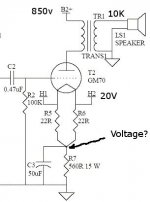On the attached circuit, how would I calculate the voltage at the indicated point so I could then calculate the operating point? Do the 22R resistors affect the voltage drop as they are in series with the cathode resistor? Is this different for a DHT then say a pentode because of the heater voltage?
Thanks in advance.
Gm-70 (from data sheet)
Cathode current (UA=180V, Vg=180V
Plate dissipation 125W
Transconductance (Ua=600V, la=160&260mA) 6mA/V
Thanks in advance.
Gm-70 (from data sheet)
Cathode current (UA=180V, Vg=180V
Plate dissipation 125W
Transconductance (Ua=600V, la=160&260mA) 6mA/V
Attachments
I don't think there is enough info to calculate the actual idle. At least for me. However, if the cathode resistor was running at it's max rating (15w) the voltage on it would be 91.5vdc and the current would be 164ma. Of course the actual idle should not be at the max rating and my guess would be it runs at 50-75%.
At 9watts on the resistor, the voltage would be 71vdc and the current would be 126ma. Under that scenario the tube would be dropping about 780vdc at 126ma = 98watts.
Yes this is speculation.
At 9watts on the resistor, the voltage would be 71vdc and the current would be 126ma. Under that scenario the tube would be dropping about 780vdc at 126ma = 98watts.
Yes this is speculation.
Thanks,
I was thinking that I was just missing something simple. I racked my brains and went through all the tube learning literature I have on cathode biasing and found nothing. I know how to figure out which resistor size to obtain a specific bias current when you know the voltage but I guess without knowing the bias current you do not have enough parameters to work backwards.
I guess I just have to build it and measure it.
I was thinking that I was just missing something simple. I racked my brains and went through all the tube learning literature I have on cathode biasing and found nothing. I know how to figure out which resistor size to obtain a specific bias current when you know the voltage but I guess without knowing the bias current you do not have enough parameters to work backwards.
I guess I just have to build it and measure it.
- Status
- This old topic is closed. If you want to reopen this topic, contact a moderator using the "Report Post" button.
